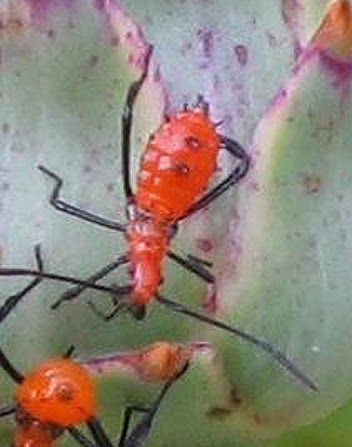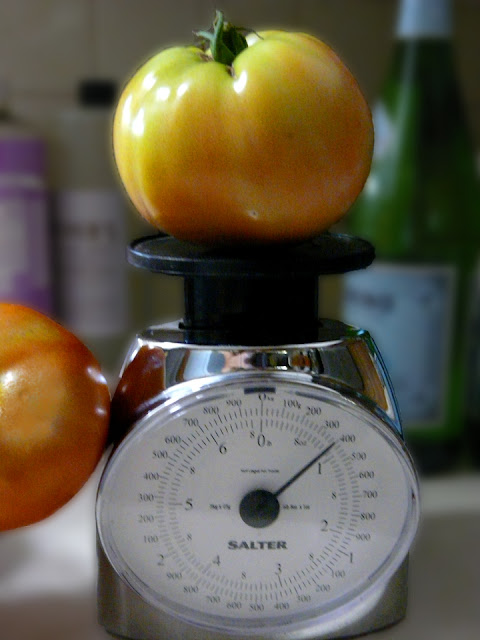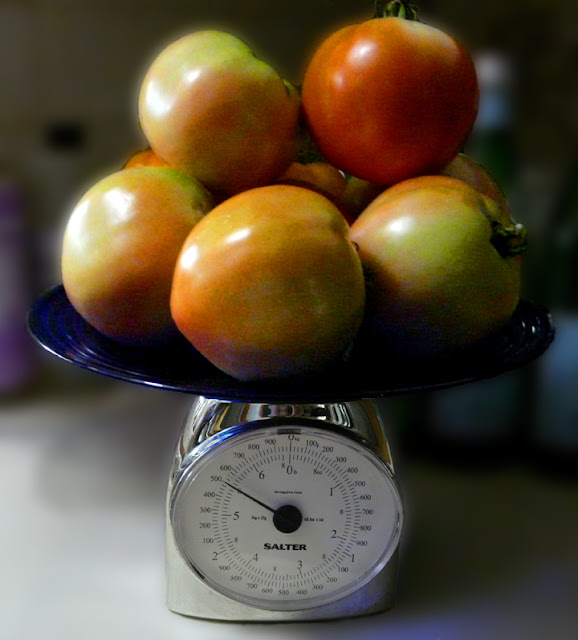I am going to talk dirt to you today. And not just any dirt. I am going to confess some seriously dirty secrets. Yes, I am talking compost. The holy grail of successful gardening - Compost. For those uninitiated in the way of organic gardening, compost can be compared to the nuclear fuel cell in the reactor. It is desired, hyped and practically worshiped by those in the know and remains a baffling mystery to the beginner or part-time gardener.
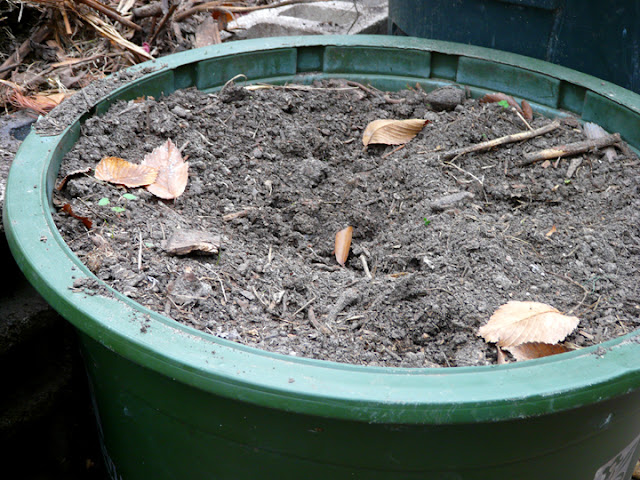 |
| Sweet mystery of life - Compost |
In general, dirt is nothing more than the broken down remains of mostly plant materials. The soil that we dig in began its life as the stuff that grows on top of it. Compost is just a fresher form of dirt. It is mostly broken down but is fluffy and light and potentially contains all sorts of nutrients that the old dirt has lost. Compost is the new hire with fresh ideas and dirt is the experienced, but let's face it, stale, long term employee.
Gardeners by and large are very suspicious of dirt. They wonder what it contains and they wonder what it is missing. Some will send their dirt out to be analyzed by a lab so they will know exactly what ratio of nitrogen, phosphorus and potassium their soil contains. Many of the gardeners who do this have no idea what nitrogen, phosphorus and potassium do for their plants, but they, upon finding one of these levels lower than appropriate, will go out and buy a fertilizer with the 'right' numbers in order to fix the problem.
Gardeners who compost scoff at such antics. They instead treat every kind of soil related problem with compost. Not enough nitrogen? Add more compost. Low in potassium? Add more compost. Got a problem with powdery mildew? Put some compost in a bucket, add water and let sit. Drain the 'compost tea' out and apply it to your plants leaves. Got a disease problem? Needs some compost. Has your garden caught fire because of extended drought like conditions and roving fire storms? Throw some compost on it. It will put it right out.
Actually, compost does solve a whole heaping bunch of problems that plague gardening. It replenishes nutrients in poor soils. It improves the tilth of hardened soils. It protects plants from many different maladies and can be used as a mulch to help retain moisture. Best of all, it is free, or nearly free if you discount the labor it takes to make it.
Because compost is such a wonderful thing, there are countless numbers of Composting Guides out there. These guides will tell you how to find things to compost in your area, such as grass clippings from neighbors, manure from stables, feathers from poultry farms - the list of what you can compost is nearly endless. The guides also go into excruciating detail about how you are supposed to layer all of this stuff so that your compost becomes hot.
Hotness in compost is the holy grail. When the grass clippings and manure and feathers and stuff start to break down, heat is produced. In fact the interior of a well built compost pile can climb upwards of 120 degrees, 150 if you get it just right. All of this heat is excellent for killing undesirable seeds from weeds and also disinfect the soil from pathogens. All of this heat also breaks down the pile so that the compost can be finished in a matter of weeks. That is the gold standard. Finished compost in a few weeks.
So, the Compost Guides go absolutely nuts about how to make a pile 'just so' in order to get to that finish line. You would think there is some sort of race going on the way people brag about their decomposing piles of dirt. Check any gardening forum or organic gardening magazine and there will be someone bragging that their compost pile is cooking at 150 and they have finished compost in just three weeks.
So, of course the novice composter will get the idea that anything less than the 150 degree/three weeks scenario is a failure. They will try to follow the step by step guides to layering and getting adequate aeration along with turning schedules. They may buy chipper shredders in order to cut the compost material into desirable, easy to decay size. They may buy costly and complex compost containers that spin. They may seek out grass clippings and manure as if they have some sort of weird fetish. And much like someone who has some sort of fetish, they may even pee on the compost pile in order to increase its nitrogen content. All of this so they too can have hot, quick compost.
The novice is also likely to give up in frustration when all their efforts fail to bring about a steaming pile or they may be reduced to an exhausted heap from their efforts of feeding the compost junkie. It is all very sad and very unnecessary because the ultimate secret of composting is this. Dirt happens. Sooner or later, if it is organic, dirt happens. It might take longer than one might think, but trust me. Dirt happens.
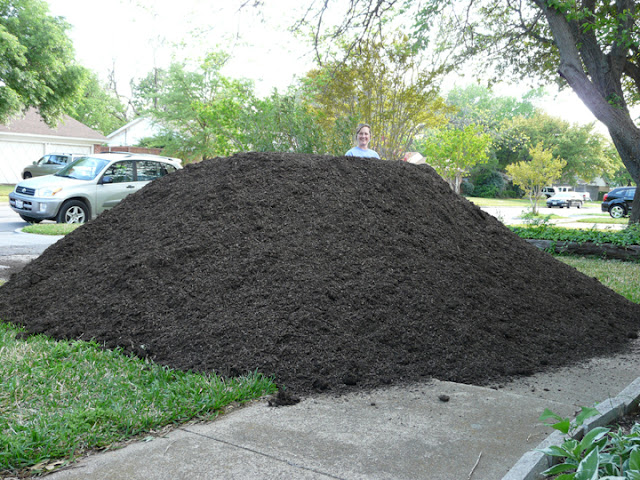 |
| You can also just buy finished compost. They don't even card you or anything. |
-----------------------------------------------------------------------------------------------------------------------------------
The No Nonsense Approach to Composting
- A realistic step by step guide
1. Find an area in your yard that is not easily seen. This is important, because although composting produces near miraculous results in your garden, it is not very attractive. The only people who find a compost pile attractive are other people who compost. Everybody else just wonders why you have a big old pile of stuff sitting in your yard. So, find a place where your pile will not be easily seen. The best location will have your pile in a slightly shady area.
2. Place something solid at the back of your pile. You might have your pile up against your fence, which will help it retain its shape, but it might eat your fence if it is wooden. Some things that work well to back your compost pile are cinder blocks or maybe some old aluminum siding you took off a building that once stood in your yard. Think five feet tall and impervious to damp soil.
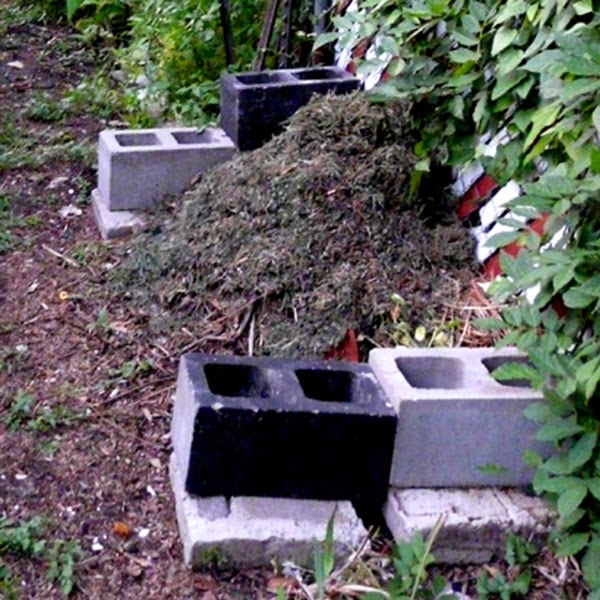 |
Cement blocks work great.
|
3. Start gathering your stuff for the pile. You want lots of fresh green stuff like grass clippings and pulled weeds. You want a little bit of stuff that is older and not green like hay or maybe some leaves, not too much leaf stuff and avoid leaves that don't break down very easily, like oak leaves. Small twigs and branches are okay and even some larger ones are fine because they will help to keep the pile aerated. If you have access to manure or feathers, great, those will work as well.
4. Put your stuff together in a pile against your solid back wall. Try not to have too much of any one thing. Mix the stuff together as much as you can so that everything is jumbled together as evenly as possible. Pile it all up in a heap about 4 feet tall at the peak. If it is not this big then you will be wanting to find more stuff to add. If it is taller than this that is okay, it will just go a little slower.
5. Water your pile of stuff until it is like a damp sponge - not too wet and not too dry. Maybe stir it a little to make sure all the stuff is damp.
6. Go away. Water it once a week or so if the weather is dry. If you want to add more stuff to it then add it to the top of the pile. If you want to add in kitchen waste then dig a hole in your pile and stuff it deep into the pile. Do not freak out if you see bugs. Bugs belong in a compost pile. Their job is to help break down the stuff.
7. This part is just for those who can physically handle it. It will make the compost go faster, but if you can't do this part don't worry - remember, dirt happens. If you can turn the compost pile, the dirt will happen faster. To turn your pile you will want a space right next to where your compost currently resides. The only tool you will really ever want to have for your compost pile is a compost fork. This wide tined thing will help you move your unfinished compost around more easily. Stick your compost fork into the top of the pile and move a scoop to a place next to the pile. You will scoop by scoop be putting your pile back together again in this new place. You can turn your pile as frequently as every week, but you can also turn it about once a month.
8. Once a few weeks have gone by you will notice your pile is much smaller than when it began. That is because dirt is happening. This will happen whether you turn your compost pile or not, but if you don't turn it it will probably be more than a month before you see much of a size change. Resist the urge to add more stuff to a pile that is already reducing substantially. If you are turning your pile remove only the stuff that is in your way when you are turning it. Some stuff takes longer to decompose. Some stuff will never decompose but helps aerate the pile.
9. If you are turning your compost you will notice there is more and more dirt every time you turn. When most of the stuff has broken down you can begin to use the compost. To do this you will want to sift out the unfinished stuff. We made a great sifter box out of some small gauge hard cloth wire and a wooden box frame. This allows us to put a fork full of finished compost into the sifter box and sift it out over a large plastic planter to collect the dirt. The unfinished stuff goes back into a new pile.
10. If you are not turning your compost then it will take months before you have some finished dirt. Wait until your pile has reduced substantially from it beginning size. Scrape off the top layer and there it is - your finished compost. You will still need to sift this in some way, but you can also use it unsifted as a mulch on top of your garden beds. Just remove the larger stuff and the various plastic debris that somehow always gets into your pile from who knows where. When compost is not turned, you typically will have to wait for an entire season for it to finish.
------------------------------------------ Tada! You Have Compost! -----------------------------------------
Some things that are great for a compost pile:
1. Kitchen waste, such as vegetable peels and stems, vegetables and fruit that have 'gone too far' in the fridge or fruit bowl, peanut and nut shells, boiled or steamed vegetables.
2. Out dated vitamins and minerals - Just don't use oil based vitamins.
3. Seaweed, shells and sand from the beach - just rinse it first.
4. Hair - human or pet.
5. Dryer lint.
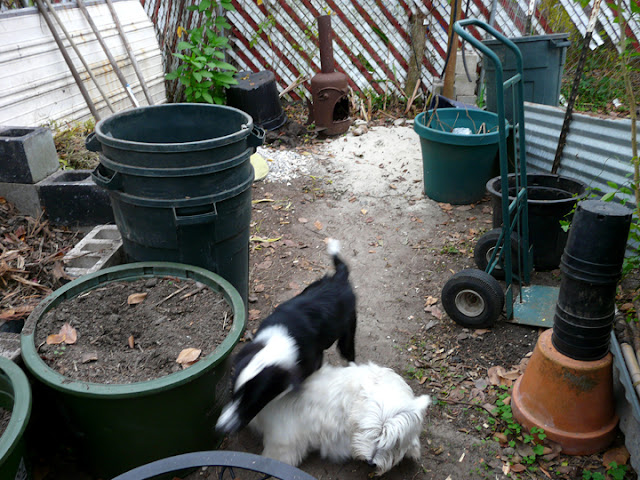 |
| Here are our dogs doing their best to add pet hair to the compost. In the background you can see some sand and shells. The shark shaped chiminea can be used to burn branches and the ashes added to the compost. It also just looks cool. |
Some things that you want to AVOID adding to a compost pile:
1. Kitchen waste containing meat scraps, oils or extremely rotted foods. If it smells bad it does not belong in the compost pile.
2. Lots of leaves. Some leaves are okay, but others contain too much tannin and are hard to break down. That being said, a separate pile can be made of only leaves and after about a year you can use this as mulch on the top of your garden beds.
3. Paper - think of this as just processed leaves.
4. Dog or cat waste - no, no, no - you don't want parasites! Okay, I know that cow, horse and elephant manure are allowed, even chickens and bunny poop is allowed - but never anything from Fifi or Fido because their stuff can make you sick.
5. Sawdust - for the same reasons as tree leaves and paper, but also because treated lumber has chromated copper arsenate - and you don't want any part of that in your compost.
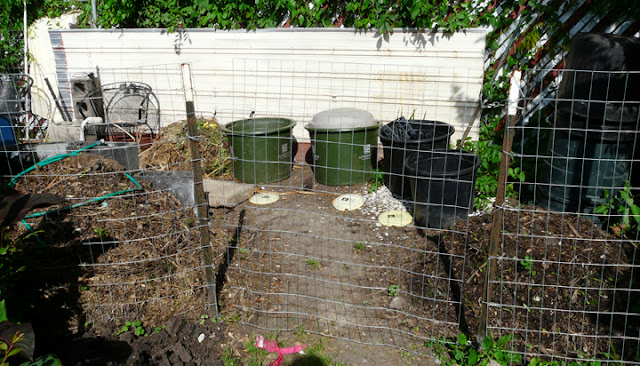 |
| Another thing you don't want in your compost is too much dog. Ours like to browse through like dumpster divers. We keep them out unless we are there to monitor their antics. |
So, composting is no big deal and it is also a big deal. You can just throw together a pile of stuff and come back in a year or you can measure and tinker and water and turn and get something faster. Composting can be practically free or you can spend some serious money on getting fancy compost bins. But by all means, compost. If you love pretty flowers, compost. If you like fresh vegetables, compost. If you just want a way to give back to the earth - literally making earth, then compost.
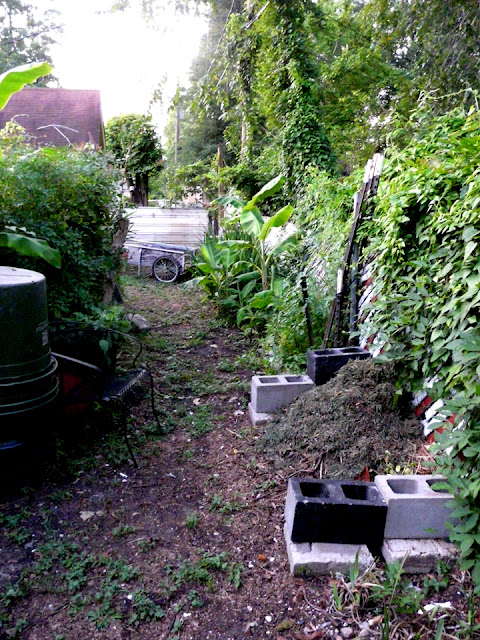 |
| The compost area several years ago. |
Our compost area has changed over the years although it has remained in basically the same section of our yard. As our garden has changed so its shape has changed and our comfort and proficiency with it has increased. There have been times when we just let a pile sit for months, but now my husband gets a good workout turning the pile each month. We feed it kitchen waste, pulled weeds, finished vegetable plants, worn out hay we used for mulch, grass clippings and various yard trimmings. We also give it any expired vitamins we come across.
It gives us about 4 or more large plastic garden pots you see in the above photo every time we sift it which is about two or three times per year. Without compost I could not be an organic gardener. Without compost I am sure I would not have been able to have five tomato plants produce over 55 pounds of tomatoes in one month. I love compost.
I also love other people's compost piles and bins. Here is my friend's lovely arrangement:
Happy Composting.






















